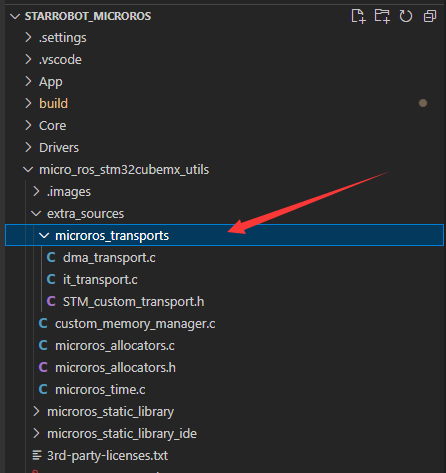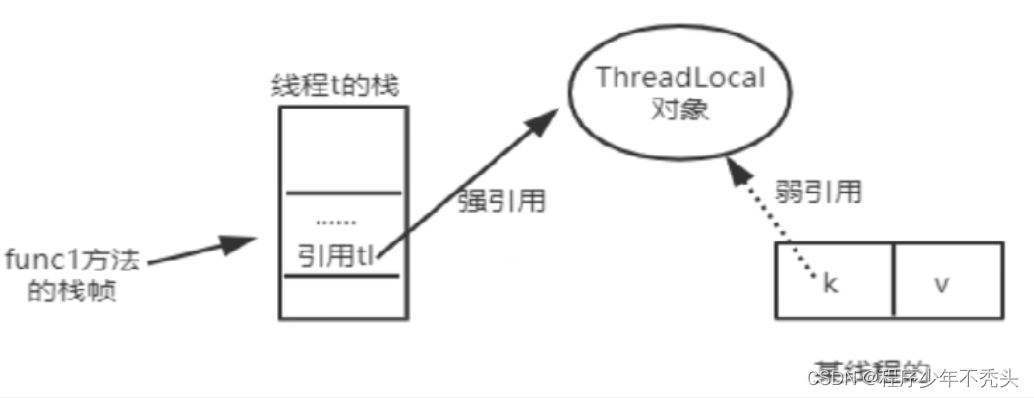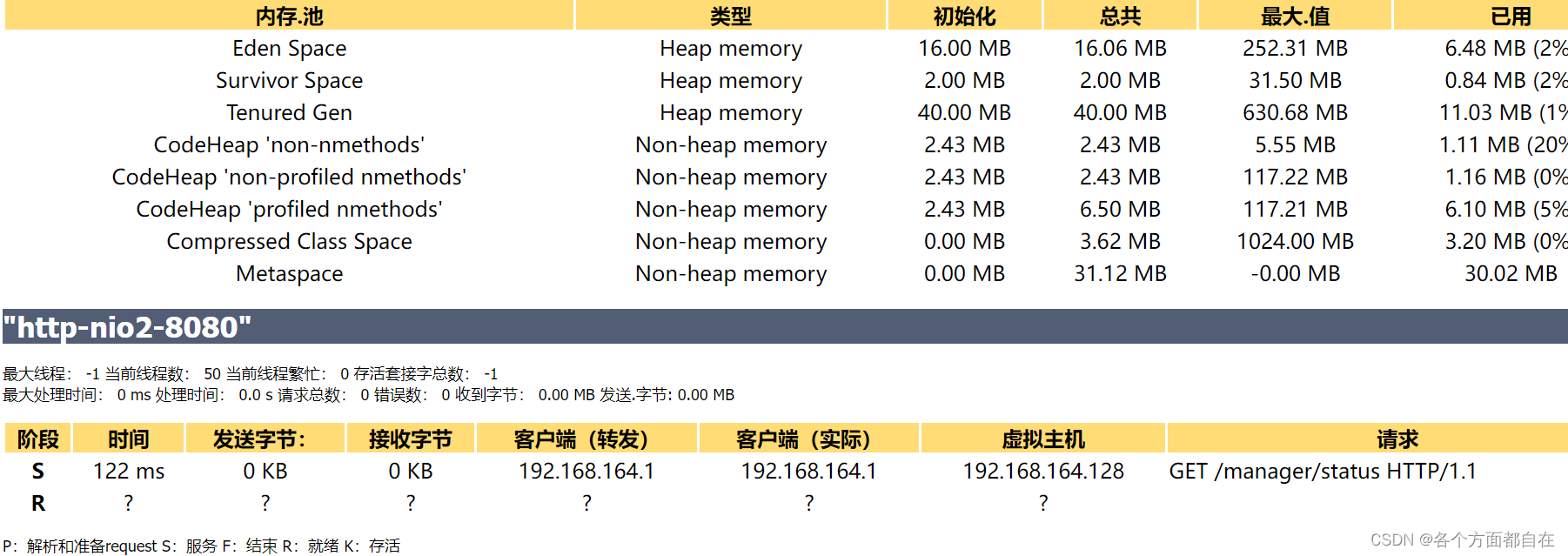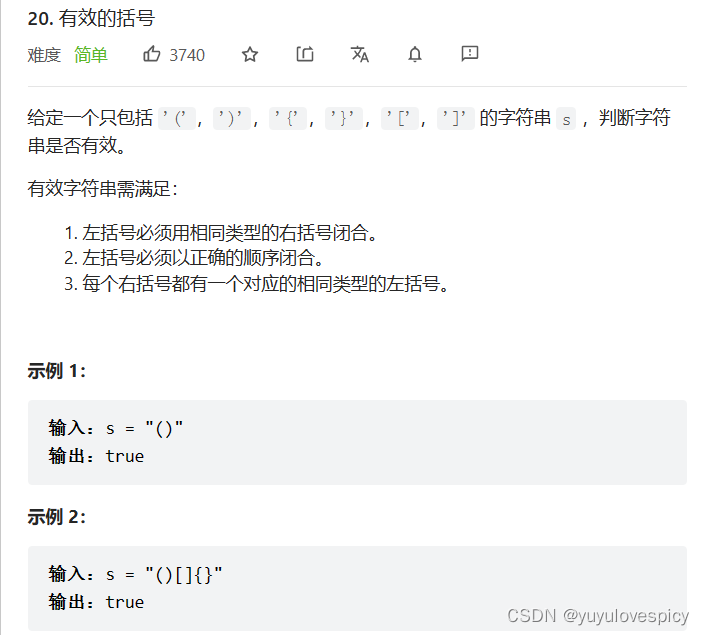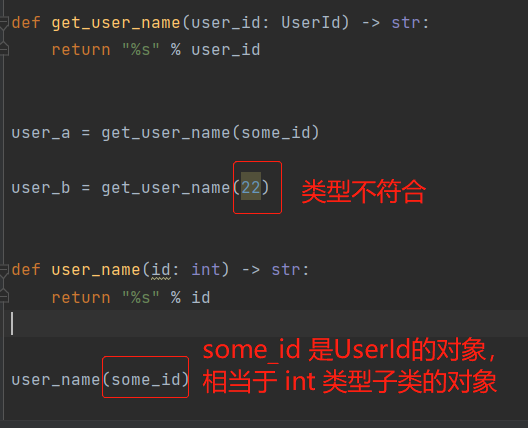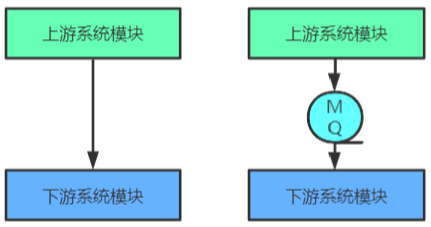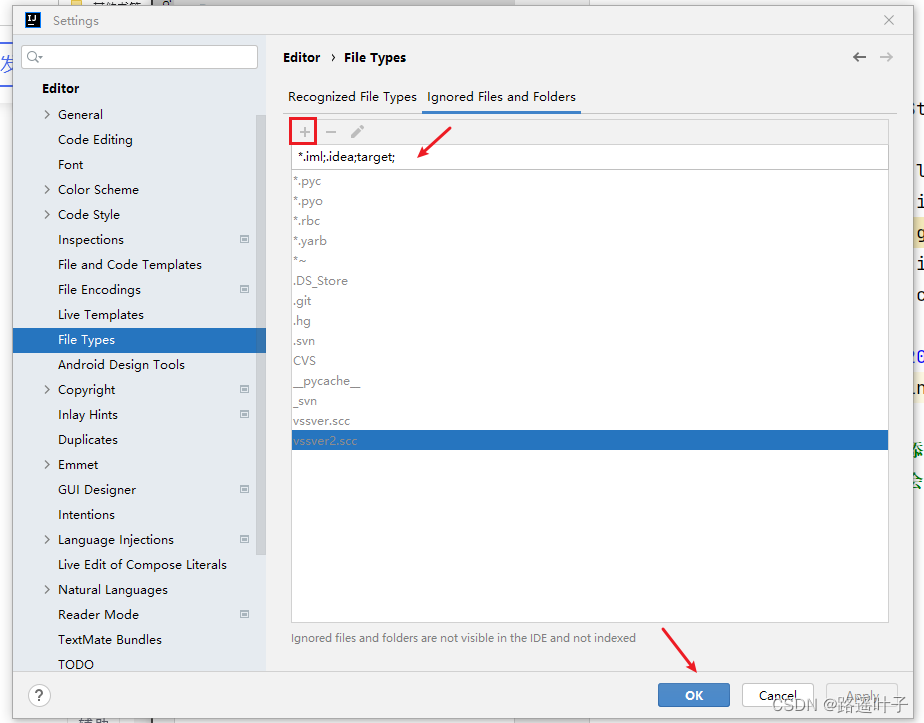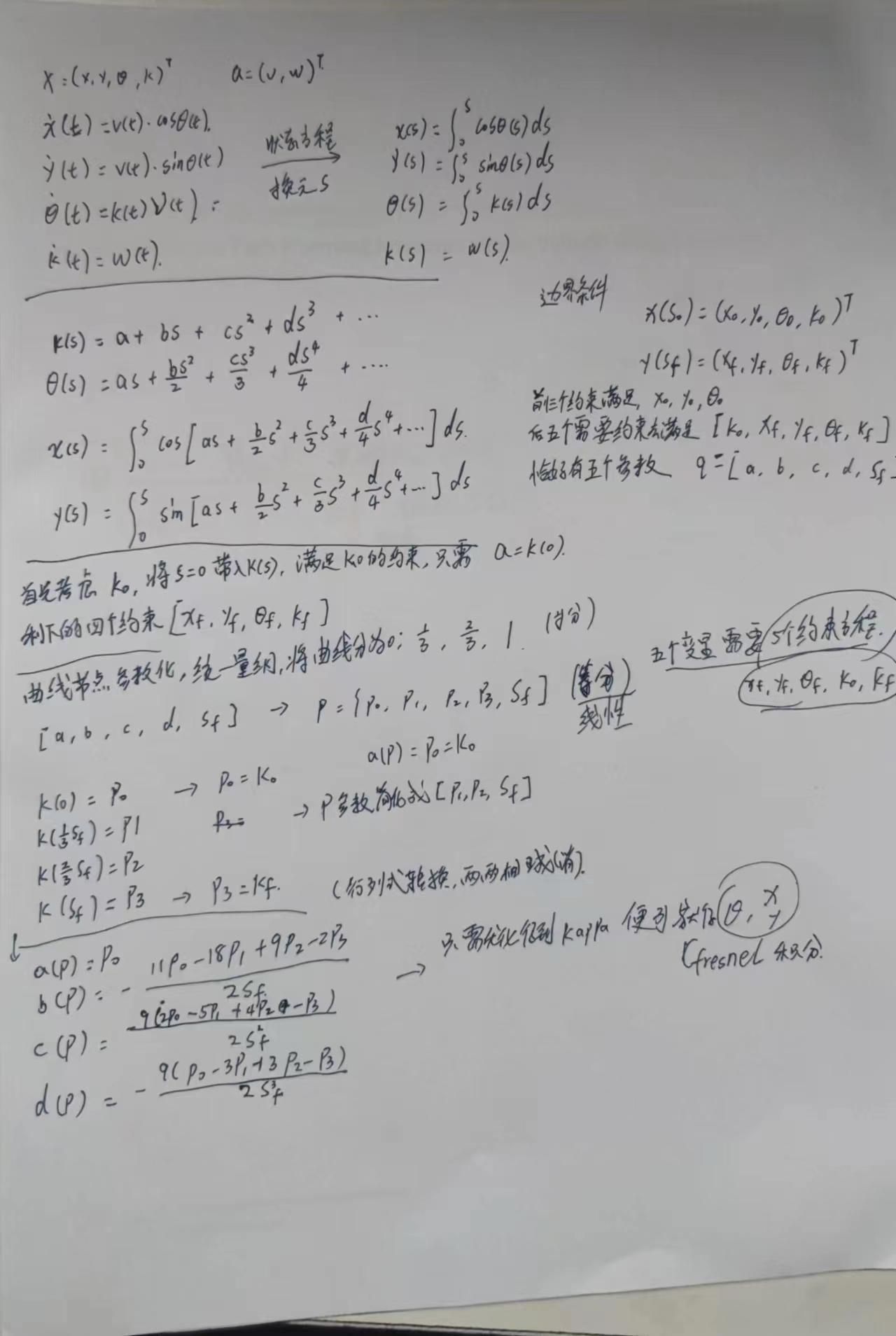编辑:OAK中国
首发:oakchina.cn
喜欢的话,请多多👍⭐️✍
内容可能会不定期更新,官网内容都是最新的,请查看首发地址链接。
▌前言
Hello,大家好,这里是OAK中国,我是助手君。
最近咱社群里有几个朋友在将yolox转换成blob的过程有点不清楚,所以我就写了这篇博客。(请夸我贴心!咱的原则:合理要求,有求必应!)
1.其他Yolo转换及使用教程请参考
2.检测类的yolo模型建议使用在线转换(地址),如果在线转换不成功,你再根据本教程来做本地转换。
▌.pt 转换为 .onnx
使用下列脚本(将脚本放到 YOLOv6 根目录中)将 pytorch 模型转换为 onnx 模型,若已安装 openvino_dev,则可进一步转换为 OpenVINO 模型:
示例用法:
python export_onnx.py -w <path_to_model>.pt -imgsz 640
export_onnx.py :
#!/usr/bin/env python3
# -*- coding:utf-8 -*-
import argparse
import json
import subprocess
import sys
import time
from pathlib import Path
import onnx
import torch
import torch.nn as nn
ROOT = Path.cwd()
if str(ROOT) not in sys.path:
sys.path.append(str(ROOT))
from yolov6.layers.common import *
from yolov6.models.efficientrep import (CSPBepBackbone, CSPBepBackbone_P6,
EfficientRep, EfficientRep6)
from yolov6.models.effidehead import Detect
from yolov6.models.yolo import *
from yolov6.utils.checkpoint import load_checkpoint
from yolov6.utils.events import LOGGER
class YoloV6BackBone(nn.Module):
"""
Backbone of YoloV6 model, it takes the model's original backbone and wraps it in this
universal class. This was created for backwards compatibility with R2 models.
"""
def __init__(self, old_layer, uses_fuse_P2=True, uses_6_erblock=False):
super().__init__()
self.uses_fuse_P2 = uses_fuse_P2
self.uses_6_erblock = uses_6_erblock
self.fuse_P2 = old_layer.fuse_P2 if hasattr(old_layer, "fuse_P2") else False
self.stem = old_layer.stem
self.ERBlock_2 = old_layer.ERBlock_2
self.ERBlock_3 = old_layer.ERBlock_3
self.ERBlock_4 = old_layer.ERBlock_4
self.ERBlock_5 = old_layer.ERBlock_5
if uses_6_erblock:
self.ERBlock_6 = old_layer.ERBlock_6
def forward(self, x):
outputs = []
x = self.stem(x)
x = self.ERBlock_2(x)
if self.uses_fuse_P2 and self.fuse_P2:
outputs.append(x)
elif not self.uses_fuse_P2:
outputs.append(x)
x = self.ERBlock_3(x)
outputs.append(x)
x = self.ERBlock_4(x)
outputs.append(x)
x = self.ERBlock_5(x)
outputs.append(x)
if self.uses_6_erblock:
x = self.ERBlock_6(x)
outputs.append(x)
return tuple(outputs)
class DetectV6R2(nn.Module):
"""Efficient Decoupled Head for YOLOv6 R2&R3
With hardware-aware degisn, the decoupled head is optimized with
hybridchannels methods.
"""
# def __init__(self, num_classes=80, anchors=1, num_layers=3, inplace=True, head_layers=None, use_dfl=True, reg_max=16): # detection layer
def __init__(self, old_detect): # detection layer
super().__init__()
self.nc = old_detect.nc # number of classes
self.no = old_detect.no # number of outputs per anchor
self.nl = old_detect.nl # number of detection layers
if hasattr(old_detect, "anchors"):
self.anchors = old_detect.anchors
self.grid = old_detect.grid # [torch.zeros(1)] * self.nl
self.prior_prob = 1e-2
self.inplace = old_detect.inplace
stride = [8, 16, 32] # strides computed during build
self.stride = torch.tensor(stride)
self.use_dfl = old_detect.use_dfl
self.reg_max = old_detect.reg_max
self.proj_conv = old_detect.proj_conv
self.grid_cell_offset = 0.5
self.grid_cell_size = 5.0
# Init decouple head
self.stems = old_detect.stems
self.cls_convs = old_detect.cls_convs
self.reg_convs = old_detect.reg_convs
self.cls_preds = old_detect.cls_preds
self.reg_preds = old_detect.reg_preds
def forward(self, x):
outputs = []
for i in range(self.nl):
b, _, h, w = x[i].shape
l = h * w
x[i] = self.stems[i](x[i])
cls_x = x[i]
reg_x = x[i]
cls_feat = self.cls_convs[i](cls_x)
cls_output = self.cls_preds[i](cls_feat)
reg_feat = self.reg_convs[i](reg_x)
reg_output = self.reg_preds[i](reg_feat)
if self.use_dfl:
reg_output = reg_output.reshape([-1, 4, self.reg_max + 1, l]).permute(
0, 2, 1, 3
)
reg_output = self.proj_conv(F.softmax(reg_output, dim=1))[:, 0]
reg_output = reg_output.reshape([-1, 4, h, w])
cls_output = torch.sigmoid(cls_output)
conf, _ = cls_output.max(1, keepdim=True)
output = torch.cat([reg_output, conf, cls_output], axis=1)
outputs.append(output)
return outputs
if __name__ == "__main__":
parser = argparse.ArgumentParser(
formatter_class=argparse.ArgumentDefaultsHelpFormatter
)
parser.add_argument(
"-w", "--weights", type=Path, default="./yolov6s.pt", help="weights path"
)
parser.add_argument(
"-imgsz",
"--img-size",
nargs="+",
type=int,
default=[640, 640],
help="image size",
) # height, width
parser.add_argument(
"--inplace", action="store_true", help="set Detect() inplace=True"
)
parser.add_argument("--opset", type=int, default=12, help="opset version")
args = parser.parse_args()
args.img_size *= 2 if len(args.img_size) == 1 else 1 # expand
print(args)
t = time.time()
# Check device
device = torch.device("cpu")
# Load PyTorch model
model = load_checkpoint(
str(args.weights), map_location=device, inplace=True, fuse=True
) # load FP32 model
labels = model.names # get class names
for layer in model.modules():
if isinstance(layer, RepVGGBlock):
layer.switch_to_deploy()
for n, module in model.named_children():
if isinstance(module, EfficientRep) or isinstance(module, CSPBepBackbone):
setattr(model, n, YoloV6BackBone(module))
elif isinstance(module, EfficientRep6):
setattr(model, n, YoloV6BackBone(module, uses_6_erblock=True))
elif isinstance(module, CSPBepBackbone_P6):
setattr(
model,
n,
YoloV6BackBone(module, uses_fuse_P2=False, uses_6_erblock=True),
)
# Input
img = torch.zeros(1, 3, *args.img_size).to(
device
) # image size(1,3,320,192) iDetection
# Update model
model.eval()
for k, m in model.named_modules():
if isinstance(m, Conv): # assign export-friendly activations
if isinstance(m.act, nn.SiLU):
m.act = SiLU()
elif isinstance(m, Detect):
m.inplace = args.inplace
model.detect = DetectV6R2(model.detect)
num_branches = len(model.detect.grid)
y = model(img) # dry run
# ONNX export
try:
LOGGER.info("\nStarting to export ONNX...")
output_list = [f"output{i+1}_yolov6r2" for i in range(num_branches)]
export_file = args.weights.with_suffix(".onnx") # filename
torch.onnx.export(
model,
img,
export_file,
verbose=False,
opset_version=args.opset,
training=torch.onnx.TrainingMode.EVAL,
do_constant_folding=True,
input_names=["images"],
output_names=output_list,
dynamic_axes=None,
)
# Checks
onnx_model = onnx.load(export_file) # load onnx model
onnx.checker.check_model(onnx_model) # check onnx model
try:
import onnxsim
LOGGER.info("\nStarting to simplify ONNX...")
onnx_model, check = onnxsim.simplify(onnx_model)
assert check, "assert check failed"
except Exception as e:
LOGGER.info(f"Simplifier failure: {e}")
LOGGER.info(f"ONNX export success, saved as {export_file}")
except Exception as e:
LOGGER.info(f"ONNX export failure: {e}")
export_json = export_file.with_suffix(".json")
export_json.with_suffix(".json").write_text(
json.dumps(
{
"anchors": [],
"anchor_masks": {},
"coordinates": 4,
"labels": labels,
"num_classes": model.nc,
},
indent=4,
)
)
LOGGER.info("Labels data export success, saved as %s" % export_json)
# OpenVINO export
LOGGER.info("\nStarting to export OpenVINO...")
export_dir = Path(str(export_file).replace(".onnx", "_openvino"))
OpenVINO_cmd = (
"mo --input_model %s --output_dir %s --data_type FP16 --scale 255 --reverse_input_channel --output '%s' "
% (export_file, export_dir, ",".join(output_list))
)
try:
subprocess.check_output(OpenVINO_cmd, shell=True)
LOGGER.info(f"OpenVINO export success, saved as {export_dir}")
except Exception as e:
LOGGER.info(f"OpenVINO export failure: {e}")
LOGGER.info("\nBy the way, you can try to export OpenVINO use:")
LOGGER.info("\n%s" % OpenVINO_cmd)
# OAK Blob export
LOGGER.info("\nThen you can try to export blob use:")
export_xml = export_dir / export_file.with_suffix(".xml")
export_blob = export_dir / export_file.with_suffix(".blob")
blob_cmd = (
"compile_tool -m %s -ip U8 -d MYRIAD -VPU_NUMBER_OF_SHAVES 6 -VPU_NUMBER_OF_CMX_SLICES 6 -o %s"
% (export_xml, export_blob)
)
LOGGER.info("\n%s" % blob_cmd)
# Finish
LOGGER.info("\nExport complete (%.2fs)" % (time.time() - t))
可以使用 Netron 查看模型结构:
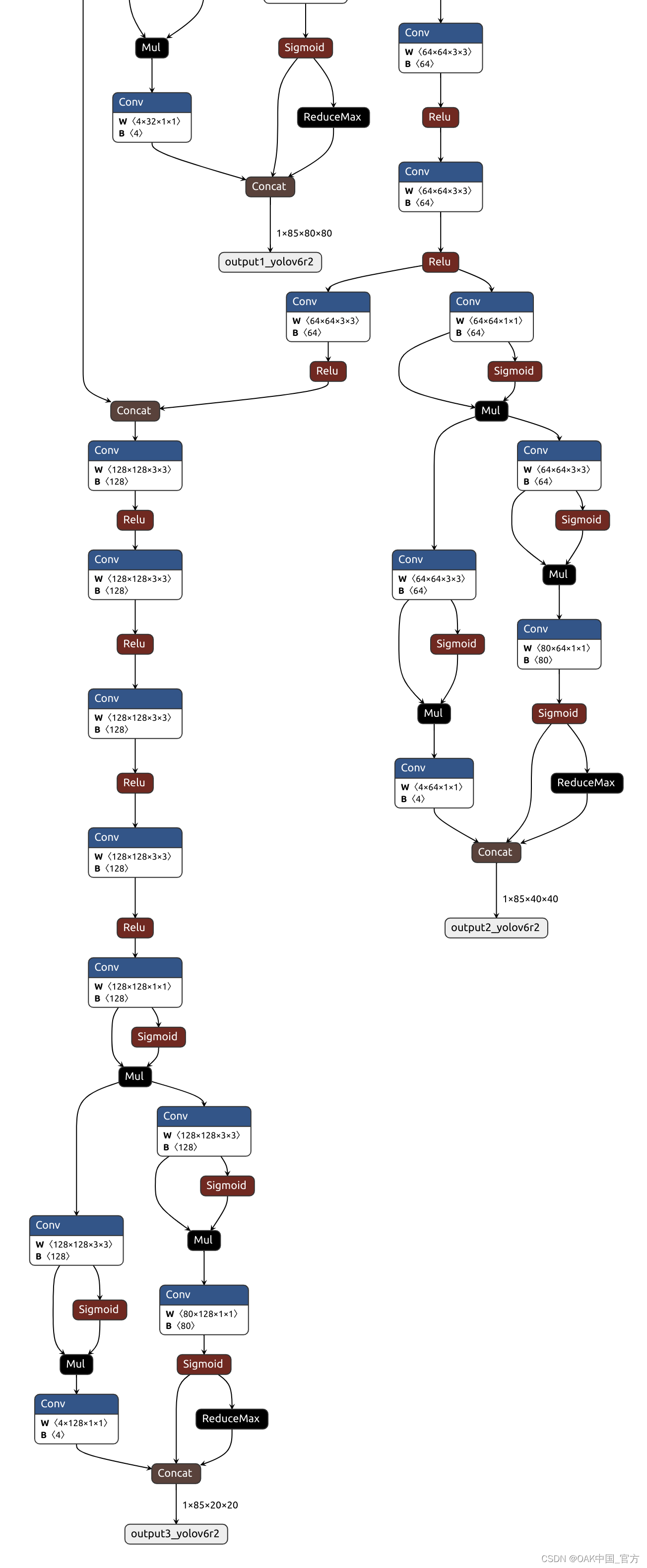
▌转换
openvino 本地转换
onnx -> openvino
mo 是 openvino_dev 2022.1 中脚本,
安装命令为
pip install openvino-dev
mo --input_model yolov6n.onnx --reverse_input_channel
openvino -> blob
<path>/compile_tool -m yolov6n.xml \
-ip U8 -d MYRIAD \
-VPU_NUMBER_OF_SHAVES 6 \
-VPU_NUMBER_OF_CMX_SLICES 6
在线转换
blobconvert 网页 http://blobconverter.luxonis.com/
- 进入网页,按下图指示操作:
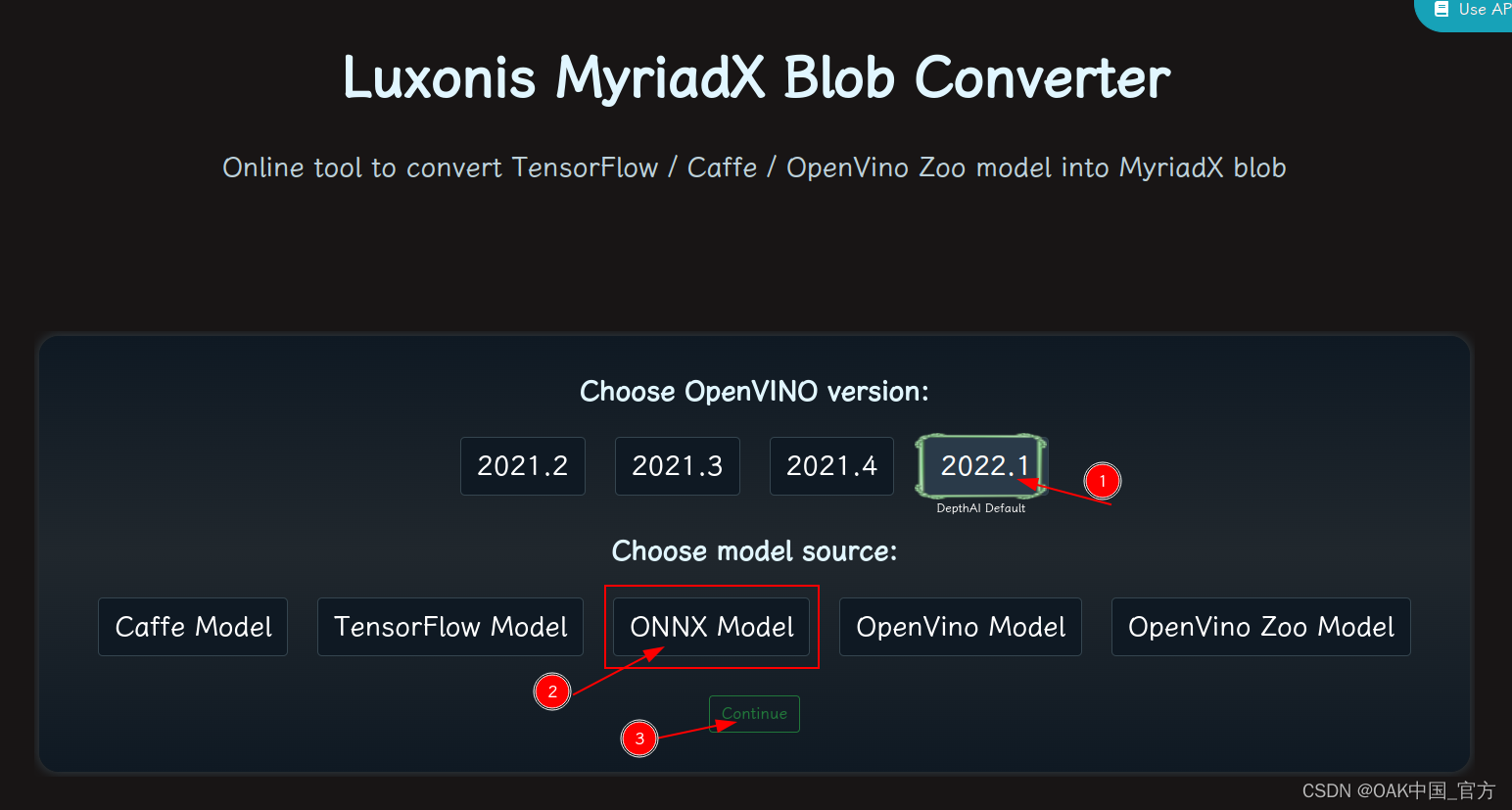
- 修改参数,转换模型:
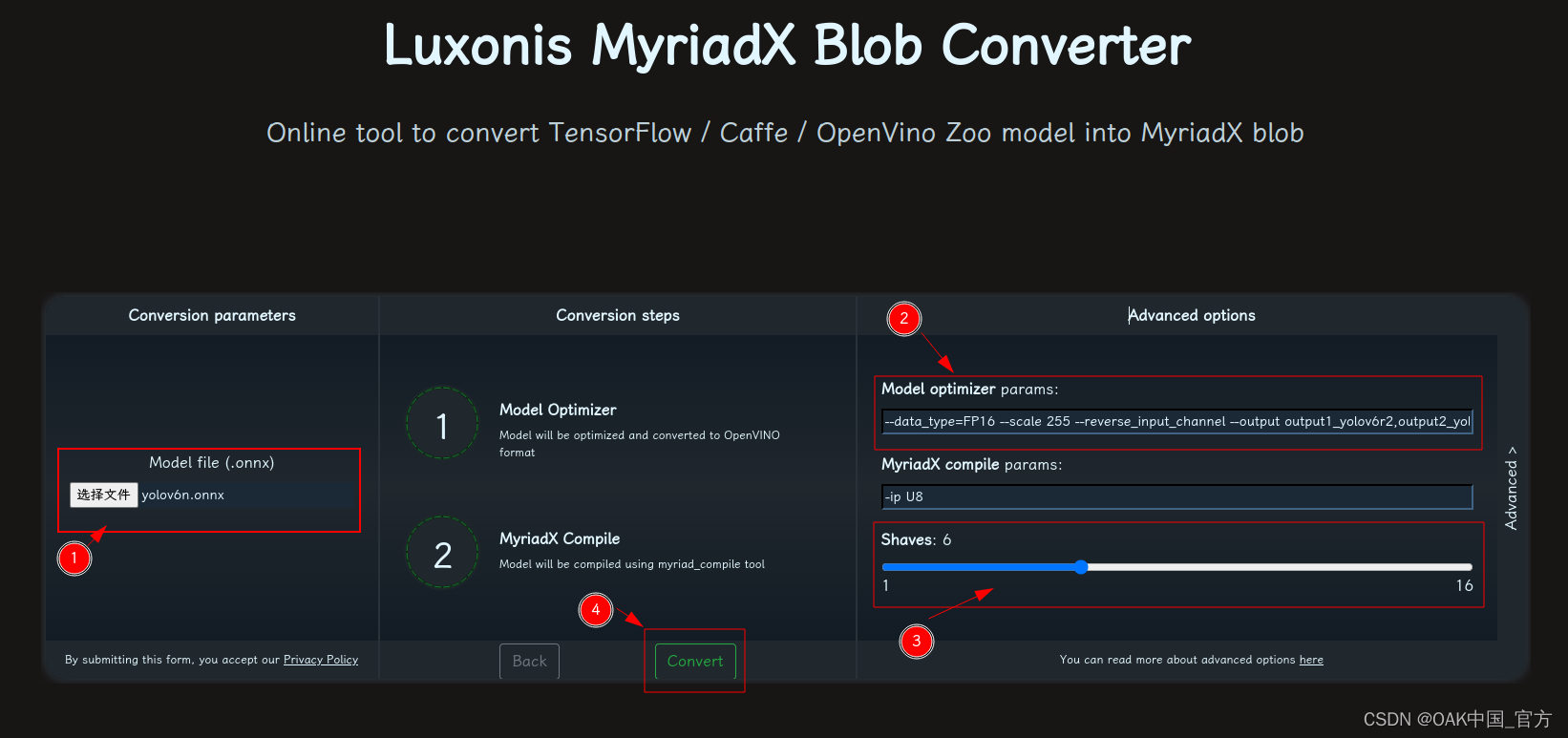
- 选择 onnx 模型
- 修改
optimizer_params为--data_type=FP16 --scale 255 --reverse_input_channel - 修改
shaves为6 - 转换
blobconverter python 代码
blobconverter.from_onnx(
"yolov6n.onnx",
optimizer_params=[
"--scale 255",
"--reverse_input_channel",
],
shaves=6,
)
blobconvert cli
blobconverter --onnx yolov6n.onnx -sh 6 -o . --optimizer-params "scale=255 --reverse_input_channel"
▌DepthAI 示例
正确解码需要可配置的网络相关参数:
- setNumClasses - YOLO 检测类别的数量
- setIouThreshold - iou 阈值
- setConfidenceThreshold - 置信度阈值,低于该阈值的对象将被过滤掉
import cv2
import depthai as dai
import numpy as np
model = dai.OpenVINO.Blob("yolov6n.blob")
dim = model.networkInputs.get("images").dims
W, H = dim[:2]
labelMap = [
# "class_1","class_2","..."
"class_%s"%i for i in range(80)
]
# Create pipeline
pipeline = dai.Pipeline()
# Define sources and outputs
camRgb = pipeline.create(dai.node.ColorCamera)
detectionNetwork = pipeline.create(dai.node.YoloDetectionNetwork)
xoutRgb = pipeline.create(dai.node.XLinkOut)
nnOut = pipeline.create(dai.node.XLinkOut)
xoutRgb.setStreamName("rgb")
nnOut.setStreamName("nn")
# Properties
camRgb.setPreviewSize(W, H)
camRgb.setResolution(dai.ColorCameraProperties.SensorResolution.THE_1080_P)
camRgb.setInterleaved(False)
camRgb.setColorOrder(dai.ColorCameraProperties.ColorOrder.BGR)
camRgb.setFps(40)
# Network specific settings
detectionNetwork.setBlob(model)
detectionNetwork.setConfidenceThreshold(0.5)
detectionNetwork.setNumClasses(80)
detectionNetwork.setCoordinateSize(4)
detectionNetwork.setAnchors([])
detectionNetwork.setAnchorMasks({})
detectionNetwork.setIouThreshold(0.5)
# Linking
camRgb.preview.link(detectionNetwork.input)
camRgb.preview.link(xoutRgb.input)
detectionNetwork.out.link(nnOut.input)
# Connect to device and start pipeline
with dai.Device(pipeline) as device:
# Output queues will be used to get the rgb frames and nn data from the outputs defined above
qRgb = device.getOutputQueue(name="rgb", maxSize=4, blocking=False)
qDet = device.getOutputQueue(name="nn", maxSize=4, blocking=False)
frame = None
detections = []
color2 = (255, 255, 255)
# nn data, being the bounding box locations, are in <0..1> range - they need to be normalized with frame width/height
def frameNorm(frame, bbox):
normVals = np.full(len(bbox), frame.shape[0])
normVals[::2] = frame.shape[1]
return (np.clip(np.array(bbox), 0, 1) * normVals).astype(int)
def displayFrame(name, frame):
color = (255, 0, 0)
for detection in detections:
bbox = frameNorm(frame, (detection.xmin, detection.ymin, detection.xmax, detection.ymax))
cv2.putText(frame, labelMap[detection.label], (bbox[0] + 10, bbox[1] + 20), cv2.FONT_HERSHEY_TRIPLEX, 0.5, 255)
cv2.putText(frame, f"{int(detection.confidence * 100)}%", (bbox[0] + 10, bbox[1] + 40), cv2.FONT_HERSHEY_TRIPLEX, 0.5, 255)
cv2.rectangle(frame, (bbox[0], bbox[1]), (bbox[2], bbox[3]), color, 2)
# Show the frame
cv2.imshow(name, frame)
while True:
inRgb = qRgb.tryGet()
inDet = qDet.tryGet()
if inRgb is not None:
frame = inRgb.getCvFrame()
if inDet is not None:
detections = inDet.detections
if frame is not None:
displayFrame("rgb", frame)
if cv2.waitKey(1) == ord('q'):
break
▌参考资料
https://www.oakchina.cn/2023/02/23/yolov6-blob/
https://docs.oakchina.cn/en/latest/
https://www.oakchina.cn/selection-guide/
OAK中国
| OpenCV AI Kit在中国区的官方代理商和技术服务商
| 追踪AI技术和产品新动态
戳「+关注」获取最新资讯↗↗



